From Limerick to Antwerp – Irish Brigades Abroad 1690-1815
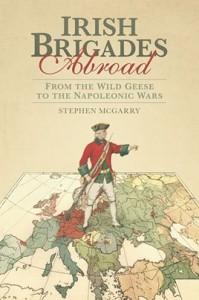
Stephen McGarry on Irish military service abroad from the Treaty of Limerick until the defeat of Napoleon. See also the Irish in Spanish service.
The tradition of Irishmen in Continental European armies dates back to 1587 when Irish regiments were formed in the Spanish army. Many were forced to seek fame and fortune abroad after failed rebellions and religious discrimination at home, particularly after defeat in the Jacobite War (1689-91), which was fought in Ireland between Jacobite supporters of the deposed Catholic king, James II, and Williamite supporters of the Protestant King, William of Orange.
The war’s repercussions were acutely felt during ‘The Troubles’ and are still felt today where triumphant murals of King Billy over the Catholics, still adorn the gable walls in Ulster as the champion of Protestant religious freedoms.
The ‘Flight of the Wild Geese and the French Irish Brigade
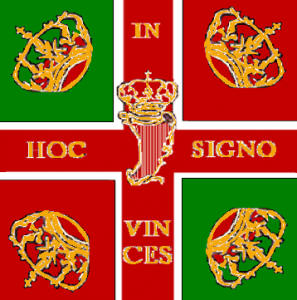
‘The Flight of the Wild Geese’ was the romantic term given when the 14,000-strong Irish army withdrew to France following the Jacobite War. The Irish army were then formed into units called ”Irish brigades” in France and Spain.
There were also Irish regiments formed in Austria, along with a long tradition of Irish service in Bavaria and in Catherine the Great’s Imperial Russia and beyond.
The Treaty of Limerick concluded the Jacobite War and guaranteed Catholic rights but these were mostly swept away when the all-Protestant Irish Parliament came to power. Prevented by anti-Catholic Penal Laws from the professions or from entering the army, many were left with no other option in an undeveloped, agrarian Irish economy than to soldier abroad.
The Irish Brigades were Catholic Ireland’s army-in-exile who sought French and Spanish patronage to bring about a free and independent Ireland. However they have been too easily dismissed by historians as mercenaries lacking a political ideology. They wore red uniforms-the colours of the deposed Catholic king, James II, as they hoped that his restoration would finally return Catholic lands and rights back home. They quickly established a reputation as the storm troopers of the Continental armies, which also took its toll in battlefield casualties.
Irishmen in French service often crossed swords with their compatriots in the British Army
The Battle of Fontenoy (1745) was the Irish Brigades highest battle honour, where six Irish infantry regiments in the French army famously broke a British infantry advance and secured victory for France. While researching the book, ‘The Irish Brigades Abroad‘ I discovered the British flag taken by the Irish Brigade that day. There has always been controversy about this flag as it was never correctly identified. But I came across a reference to it in a French newspaper from 1745 and was finally able to track it down in an illustrated hand-painted manuscript in the research library in Paris. This Colour came from Sempill’s Regiment of Foot (forerunner of the king’s Own Scottish Borderers) and not from the Coldstream Guards as was previously thought.
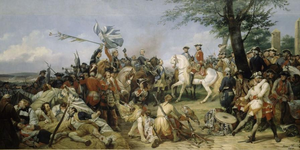
Irishmen frequently faced their fellow countrymen on the field of battle and this sadly occurred far too often. In 1702, Irish troops in the Imperial Austrian army fought their compatriots in the French army in the Italian town of Cremona. An epic musket duel was fought during the Battle of Malplaquet between two Irish units, one in the British, and the other in the French army.
As the momentum gathers pace on the question of Scotland’s independence we recall the Irish military diaspora’s efforts to sever the 1707 Union between Scotland and England and restore Scotland’s parliament. The 1707 Union reduced Scotland’s autonomy and power and was seen by many of the fiercely independent Highlanders and by some Lowland Scots as deeply unjust and a ‘slavish subjugation.’
The Irish were heavily involved in a 1715 Franco-Jacobite invasion of the British Isles to restore the Stuarts. James Butler the Duke of Ormond landed in south east England with a number of senior Irish officers and an Irish cavalry detachment from Nugent’s horse, but the mission was an unsuccessful one and they were forced to return to France. The invasion then focused on Scotland but the rising was quickly quashed out.
In February 1744, Irish Jacobites were again involved in a plan to invade England to restore James II’s grandson, fondly known as Bonnie Prince Charlie, to the British throne. The invasion force under Marshal of France, Maurice de Saxe comprised 10,000 troops, which included 3,000 troops from the Irish Brigade of France. However when the French covering squadrons and the troop transports cleared port, the fleet was dispersed due to heavy storms and the planned invasion was in the end abandoned.
The Irish Brigade of the French, originally founded by Irish Catholic Jacobites in the 1690s was disbanded after the Revolution of 1789.
But the following year, taking advantage of the British defeat at Fontenoy and with French support lacking, Charles turned to the Irish community in France for help in organising another rising in Scotland. Officers in the Irish Brigade organised a French expeditionary force made up of ‘pickets’ (volunteers) from the Irish regiments of France to form a bridgehead for the main invasion.
However the vigilance of the English Channel Fleet prevented the main French fleet to leave port, leaving only a composite Irish battalion of around 500 men to serve in the Scottish campaign where they bravely stood beside the clansmen at Culloden. While the Highlanders fled from the battlefield, the Irish pickets bravely covered their retreat and prevented a massacre on the battlefield. The defeat of the Jacobites at Culloden practically put an end to any hope of a Stuart Restoration and for any Irish hopes of regaining their lost lands and rights back home.
‘For in far foreign fields from Dunkirk to Belgrade’, Thomas Davis wrote famously, ‘lie the soldiers and chiefs of the Irish Brigade.’ After several years of army service many ventured into business. Some established the ‘wine geese’ vineyards, many of whom are still operating today, such as the Bartons and Lynch’s. Richard Hennessy served in Clare’s Regiment and later founded his famous distillery in Cognac. Others used their success for political purposes and funded Bonnie Prince Charlie’s campaign to reclaim the Stuart crown in the 1745 Scottish Rising. Irishwomen became Ladies-In-Waiting to the French queen, Queen Antoinette, and had fashionable boutiques on the Champs Elysees.
Well over 50,000 Irishmen served in the Irish Brigades and thousands rose to high rank across Europe.
Napoleon’s Irish Legion
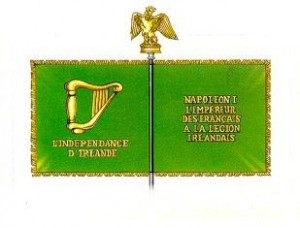
The Irish Brigade of France proved themselves as an elite unit in the French army for 100 years before they were disbanded during the French Revolution.
But several years later, in 1803, Napoleon formed a new Irish unit to spearhead an invasion of Ireland. They were called Napoleon’s Irish Legion and comprised many United Irishmen who had fled to France following the 1798 and 1803 Rebellions.
The Legion was a distinct Irish unit from the very start as they were dressed in emerald green uniforms faced with gold and received their new regimental green Colour with a gold harp in each corner inscribed with ‘Liberte des Conscience/Independence d’Irlande’ (‘Freedom of Conscience/Independence to Ireland’). They were initially raised as one battalion but were later raised to a four-battalion regiment, of around 2,000 men.
In 1803 Napoleon Bonaparte raised a 2,000 strong ‘Irish Legion’ composed principally of republican veterans of the 1798 and 1803 rebellions in Ireland.
In December 1804, they received Napoleon’s cherished bronze-cast Imperial Eagle, which he personally presented to the best regiments in the French Army, pledged to defend it to death, the eagle became a battlefield prize (like a regiment’s flags) as its capture brought shame and dishonour. The Irish prevented their eagle being captured on two occasions, once by the British in the Low Countries in 1810 and two years later by the Russians while campaigning in Poland.
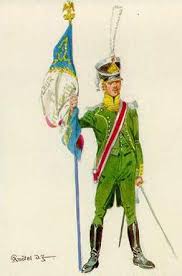
Like their forerunners in the Irish Brigade, Napoleon’s Irish Legion also crossed swords with Irish units in the British army.
When the Legion was serving in Holland and Spain they faced the formidable 88th Foot, the Connaught Rangers, raised primarily from men from the west of Ireland.
One can imagine the scene of the two Irish regiments advancing towards each other while they both played the same regimental airs of ‘Saint Patrick’s Day in the Morning’ to rally their troops before the attack, but from opposite sides!
Two hundred years ago this month, in 1814, the 500-strong Irish Legion battalion were serving in the Low Countries and were stationed in the Belgian city of Antwerp when it was besieged by a British army as part of the Allied invasion of French occupied Belgium against Napoleon. The Legion held out for three months but lifted the siege when Napoleon was removed from power in May. The Siege of Antwerp was to be their last major action, as the unit was shortly afterwards disbanded, ending a 125-year-old tradition of Irish service in France.
The Irish Legion was disbanded after Napoleon’s deposition as Emperor of France in 1814. Their last action was at the Siege of Antwerp
During the Napoleonic period there were ten Irish-born generals in the French army, and many of their names of are engraved on the Arc de Triomphe in Paris. Henry Clarke was Napoleon’s Minister of War and was central to the creation of the ‘Grand Army’ and was on horseback beside Napoleon at Waterloo. General Charles Kilmaine born and bred in Temple Bar, Dublin was one of the few officers Napoleon had complete confidence in and commanded the French army in Italy.

Their legacy was felt well into the 20th Century. Probably the most famous Frenchman of all time, President Charles De Gaulle was descended from the powerful MacCartan clan who ruled part of Co. Down for centuries before they were unseated during the English Conquest. De Gaulle’s ancestor was Anthony MacCartan who went to France with the ‘Flight of the Wild Geese’ and served as a captain in the Irish Brigade. Ireland experienced a ‘brain drain’ in the ‘long’ eighteenth-century with so many eminent Irish Catholic gentry families being driven away. Ireland’s loss certainly turned out to be Europe’s gain.
Stephen McGarry is the author of Irish Brigades Abroad (Dublin 2013). He is an author and historian who has been researching the subject for many years, both in Ireland and across Europe.